| Frank Bernheisel: The View From Here |
 Frank Bernheisel |
Posted 01.06.17 Just Outside Washington FRANK
BERNHEISEL
Winding down
The Viking Akun had cruised through the night on the Volga as it wandered through the Russian Plain, which is characterized by low hills and woods. We arrived in Yaroslavl just after breakfast about 8 a.m. . This city of about 600,000 was founded about 1000 CE on the banks of the Volga River on the site of a Viking village. The Volga turns south at this point. The Vikings used the river as their route to the Caspian Sea.
We assembled for our tour of the town. Our first stop was the Church of the Ascension of Christ, originally built in stone in about 1210 and rebuilt in its current form in 2010. We approached the church from the back through a large park across from the Soviet Square and past the memorial to Soviet soldiers killed in WWII.
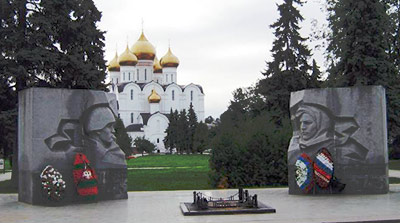 We walked through the park along the river promenade to the front of the church. The park was immaculate with walkways, lawns, and flowers; there was no litter and no graffiti. Since it was August our timing for the visit was perfect; it was cloudy but comfortable "jacket" weather. However, in November the average temperature drops below freezing and stays there through March.
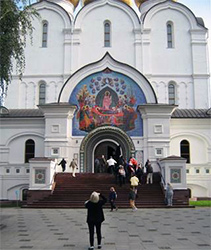 This shows the entrance to the church with the superb ceramic tile surrounding the doorway and in the fresco above.
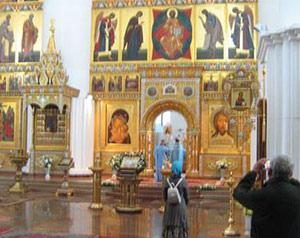 The interior picture shows the Templon or iconostasis. If you look closely you will see two priests in blue robes in the "Beautiful Gate", which leads to the Sanctuary. There are many Icons all designed and placed according to the Russian Orthodox Church requirements (there is actually a church manual on the subject). These were all new and gleamed with gold.
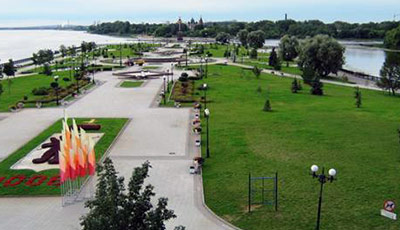 The church faces the confluence of the Volga and the Kotorosl Rivers where a new park, left picture, has been constructed celebrating the official founding of the city in 1006. The park was well below the Volga-Promenade on which we walked.
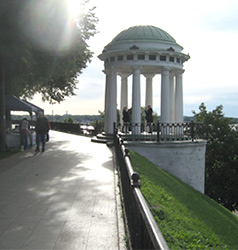 The promenade and the pavilion, right picture, were built in the 19th century during a period of major development and industrialization in the city. Yaroslavl still produces textiles, ceramics, jewelry, lace, and crafts.
 We boarded our coach for a short ride to the center of Yaroslavl to visit the central city market. The food portion of the market was inside the market building and had many stalls selling fresh local produce, as well as produce from southern Russia.
 In addition to fresh produce, the market had fresh local meat and poultry, right picture. One of the favorite stall for our group was the chocolatier. Russians pride themselves on the quality of their chocolate; it was quite tasty. The courtyard of the market had many stalls with clothing including woolen sweaters, socks and hats, and fur and leather goods. The fur coats looked very tempting but Kathy said "no." Yaroslavl is a pleasant town to walk in, particularly since the day had turned warm and sunny. The city became an administrative center in the 18th century, which spurred its development. Its administrative role results in official buildings in the neoclassical style side by side with those of the Soviet era on the large public square; the hammer and sickle are visable.
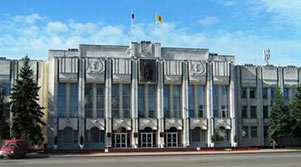 As with Moscow and the other towns we visited, there was no litter and no graffiti; I may have mentioned this before. Much of the center of Yaroslavl, shops, apartments and other official buildings were also built in the 18th century in the neoclassical style. The exceptions include the four other churches and the Monastery of the Transfiguration of the Savior. The monastery was built in the 13th century with 10-foot thick walls, which is where Ivan the Terrible took refuge from the Mongols in 1571. After our walk around the city center, we were treated to a concert and royal dance at the Governor's Palace. Several members of our group were invited to dance with members of the dance ensemble. The grand piano in the ball room of the palace looked like the one we inherited from my mother. I checked and it was the same, a Blëthner made in Leipzig, Germany.
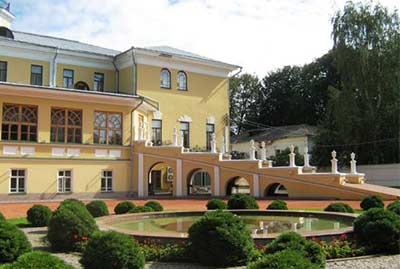 After our concert and dance we walked through the palace garden, and then back to the square to meet our coach.
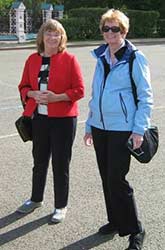 Above -- Julie and Kathy in the main square. The coach took us back to the Viking Akun, which cast off and continued our trip north out of the Volga River and into the Rybinsk Reservoir. It was time for a late lunch. After lunch we were treated to another presentation on Russian history by one of our guides. During the reign of Ivan the Terrible (1547-1584), the Russian principalities gave up their traditional rights and submitted to the rule of the Tsar. Yaroslavl prospered. The prosperity ended with the 'years of troubles,' which lasted from around 1598 until 1613. First, came the famine and then came Polish-Lithuanian troops 'intervening' in the troubled Russian state. The Polish and Lithuanians supported the pretender, Dmitry, to the Russian throne and captured Moscow. Yaroslavl was plundered by the forces of the pretender Dmitry. Russians have long memories and so it is not surprising that they, and Mr. Putin, are concerned about the Baltic States.
 The afternoon cruise took us out of the Rybinsk Reservoir and into the Volga Baltic Waterway where we passed a number of towns and a lot of factories, which had port facilities on the waterway. Many of the factories looked run down, poorly maintained, and some looked closed. However, the towns and their churches looked well maintained.
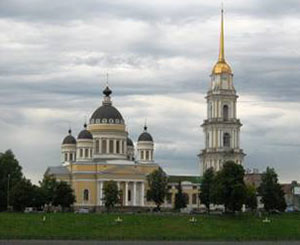 At cocktail time Viking held a party for those of us who had been on Viking cruises previously. It was very nice with champagne and hors d'oeuvres served. This was our fourth cruise with Viking, but we felt like novices as some people had been on seven or eight cruises. After the Champagne we went to dinner with Julie and Jon. We had developed a custom of finding a table for six or eight. That way we were able to meet some of our fellow travelers. This cruise was geared for English speakers, so we were able to meet people from Canada, Australia, and England. Conversations were interesting; travel truly does broaden ones' horizons. |